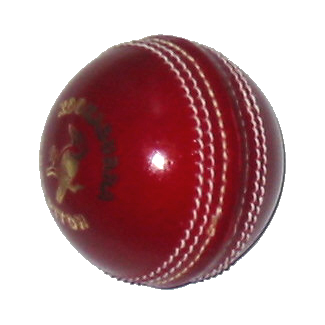A cricket ball is a hard, solid leather ball used to play cricket. Constructed of cork and leather, a cricket ball is heavily regulated by cricket law at first class level. The manipulation of a cricket ball, through employment of its various physical properties, is the staple component of bowling and dismissing batsmen – movement in the air, and off the ground, is influenced by the condition of the ball and the efforts of the bowler, while working on the cricket ball to obtain an optimum condition is a key role of the fielding side. The cricket ball is the principal manner through which the batsman scores runs, by manipulating the ball into a position where it would be safe to take a run, or by directing the ball through the boundary.
In Test cricket and most domestic games that spread over a multitude of days, the cricket ball is traditionally coloured red. In many one day cricket matches, the ball is coloured white. Training balls of white, red and pink are also common, and wind balls and tennis balls in a cricket motif can be used for training or unofficial cricket matches. During cricket matches, the quality of the ball changes to a point where it is no longer usable, and during this decline its properties alter and thus influence the match. Altering the state of the cricket ball outside the permitted manners designated in the rules of cricket is prohibited during a match, and 'ball tampering' has resulted in numerous controversies.
Cricket balls, weighing between 155.9 and 163.0 grams, are known for their hardness and for the risk of injury involved when using them. The danger of cricket balls was a key motivator for the introduction of protective equipment. Injuries are often recorded in cricket matches due to the ball, and a small number of fatalities have been recorded or attributed to cricket balls.

No comments:
Post a Comment